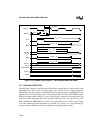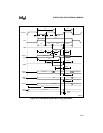
8XC196NP, 80C196NU USER’S MANUAL
13-32
If the 8XC196Nx has a pending external bus cycle while it is in hold (another device has control
of the bus), it asserts BREQ# to request control of the bus. After the external device responds by
releasing HOLD#, the 8XC196Nx exits hold and then deasserts BREQ# and HLDA#.
13.7.1 Enabling the Bus-hold Protocol
To use the bus-hold protocol, you must configure P2.3/BREQ#, P2.5/HOLD#, and P2.6/HLDA#
to operate as special-function signals. BREQ# and HLDA# are active-low outputs; HOLD# is an
active-low input.
You must also set the hold enable bit (HLDEN) in the window selection register (WSR.7) to en-
able the bus-hold protocol. Once the bus-hold protocol has been selected, the port functions of
P2.3, P2.5, and P2.6 cannot be selected without resetting the device. (During the time that the pins
are configured to operate as special-function signals, their special-function values can be read
from the P2_PIN.x bits.) However, the hold function can be dynamically enabled and disabled as
described in “Disabling the Bus-hold Protocol.”
13.7.2 Disabling the Bus-hold Protocol
To disable hold requests, clear WSR.7. The 8XC196Nx does not take control of the bus immedi-
ately after HLDEN is cleared. Instead, it waits for the current hold request to finish and then dis-
ables the bus-hold feature and ignores any new requests until the bit is set again.
Sometimes it is important to prevent another device from taking control of the bus while a block
of code is executing. One way to protect a code segment is to clear WSR.7 and then execute a
JBC instruction to check the status of the HLDA# signal. The JBC instruction prevents the RALU
from executing the protected block until current hold requests are serviced and the hold feature
is disabled. This is illustrated in the following code:
DI ;Disable interrupts to prevent
;code interruption
PUSH WSR ;Disable hold requests and
LDB WSR,#1FH ;window Port 2
WAIT: JBC P2_PIN,6, WAIT ;Check the HLDA# signal. If set,
;add protected instruction here
POP WSR ;Enable hold requests
EI ;Enable interrupts
13.7.3 Hold Latency
When an external device asserts HOLD#, the 8XC196Nx finishes the current bus cycle and then
asserts HLDA#. The time it takes the device to assert HLDA# after the external device asserts
HOLD# is called hold latency (see Figure 13-16 on page 13-31). Table 13-13 lists the maximum
hold latency for each type of bus cycle.


















